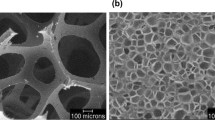Abstract
Viscous drag reduction on fan, compressor and turbine blades may be achieved by employing a riblet surface structure. Such a structure assists in increasing efficiency and in reducing energy consumption in flow applications. In order to produce riblet surface structures industrially, a new and incremental rolling process is being developed and investigated. The process design is being determined by common airstream requirements as well as the forming mechanisms that are predominant during the rolling process. Based on this principle, the required shape of the structured rollers is being developed. Research is focused on the feasibility of manufacturing small riblet structures at a size of a few hundred microns. Experimental production of different riblet geometries made from Ti-6Al-4V (WL 3.7164) provides some initial insights with respect to feasibility, shape accuracy, surface quality, and micro structure.








Similar content being viewed by others
References
Bruse M (1999) Zur Strömungsmechanik wandreibungsvermindernder riblet-Oberflächen. Dissertation, TU Berlin
Choi H, Moin P, Kim J (1993) Direct numerical simulation of turbulent flow over riblets. J Fluid Mech 255:503–539
Ninnemann T, Wing F (2004) Loss reduction using riblets on a supersonic through-flow fan blade cascade, transactions of the ASME. J Fluids Eng 126:642–649
Bechert DW, Bruse M, Hage W, van der Hoeven JGT, Hoppe G (1997) Experiments on drag-reducing surfaces and their optimization with an adjustable geometry. J Fluid Mech 338:59–87
Walsh MJ (1983) Riblets as a viscous drag reduction technique. AIAA J 21:485–486
Bechert DW, Bruse M, Hage W (2000) Experiments with three-dimensional riblets as an idealized model of shark skin. Exp Fluids 28:403–412
Denkena B, Reichstein M, Wang B (2006) Fertigung mikrofunktionaler Riblet-Strukturen durch Schleifen. wt Werkstattstechnik online 96, pp 353–358
Bargel HJ, Schulze G (2005) Werkstoffkunde. 9th edn. Springer, Heidelberg
Klocke F, König W (2006) Fertigungsverfahren Umformen. 5th edn. Springer, Heidelberg
Peters M, Leyens C (2002) Titan und Titanlegierungen. Wiley-VCH, Berlin
Acknowledgments
The research presented here was carried out with the support of the Volkswagen Foundation within the framework of the “RibletSkin” research project. The research of the fluid dynamics is carried out by the Institute of Aerodynamics (AIA) of the RWTH Aachen.
Author information
Authors and Affiliations
Corresponding author
Rights and permissions
About this article
Cite this article
Klocke, F., Feldhaus, B. & Mader, S. Development of an incremental rolling process for the production of defined riblet surface structures. Prod. Eng. Res. Devel. 1, 233–237 (2007). https://doi.org/10.1007/s11740-007-0031-y
Received:
Accepted:
Published:
Issue Date:
DOI: https://doi.org/10.1007/s11740-007-0031-y




